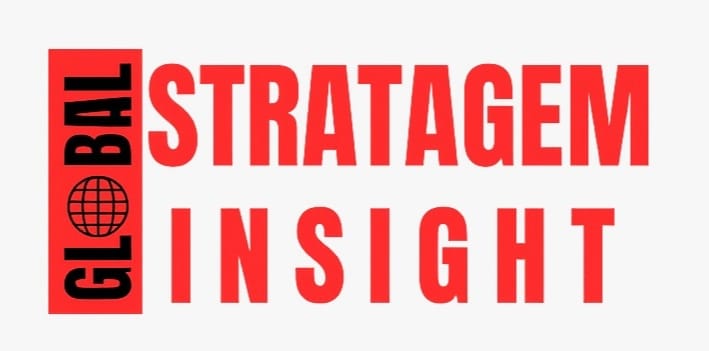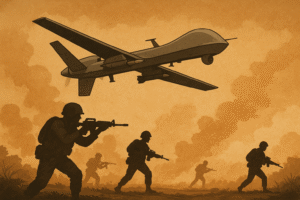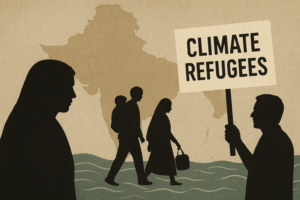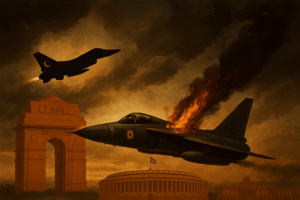Memetic Warfare and the New Age of Conflict: Lessons from the India-Pakistan Tensions

An artistic depiction of increasing drone warfare capabilities in South Asia, highlighting India's autonomous drone fleet and its implications for regional security.
Meme warfare, also known as memetic warfare, presents a modernisation of the traditional information warfare and psychological warfare that uses groups of internet memes to manage perceptions, narratives, and sociopolitical orientation among the public. Grounded in Richard Dawkins’ theory of “memes” as units of cultural transmission, this strategy has grown into an effective weapon, especially in the digital world and social media sites.
Memetic warfare is one of the important features of the information battleground during the current India-Pakistan tensions. Both state and non-state actors have used memes to spread nationalistic rhetoric, mock enemies, and spread disinformation.
For example, in the case of the Pak-India standoff in recent times, there was a sudden outflow of memes on X (formerly Twitter), Facebook and Instagram, to create the sense of domestic morale and international perception. Such memes are often used to simplify complex geopolitical matters into consumable content; however sometimes used for manipulating people’s opinions and possibly increasing tensions.
Conciseness of action and the possibility of spreading naturally emotionally charged content, partially losing the sense of satire, is the strength of meme warfare. This phenomenon highlights the necessity of enhanced media literacy and critical discourses of online content, particularly in areas with conflict potential. Amidst the development of meme warfare, the means and implications of this new phenomenon gain critical importance for policymakers, scholars, and general citizens.
The Digital Battlefield
The latest escalation of India and Pakistan has highlighted the increased role of digital platforms in contemporary conflicts. Beyond traditional military wars, both countries have actively been embroiled in online information warfare, where they have used memes and social media narratives to create public perception and international view of the war.
In the course of the 2025 standoff, India’s “Operation Sindoor” claimed to have attacked terrorist structures inside Pakistan, and, in response, Pakistan’s “Operation Bunyan al Marsoos” (آپریشن بُنۡیَانٌ مَّرۡصُوۡصٌ,) hit Indian military installations. These were not only military manoeuvres but also generators of a spike in online propaganda.
The social media platforms have transformed into battlegrounds for the state and non-state players to propagate memes that would encourage nationalistic sentiments and demonise the other side. As memes, Indian netizens shared posts celebrating the precision of their airstrikes, and Pakistani users countered with memes making fun of the false military claims of India against attacks in Pakistan and the resulting civilian casualty reports. This online exchange heightened public sentiments, most of the time without any distinction between factual reporting.
The cyber weaponisation of memes in this case helps show a change in the war dynamics, with shaping the narrative becoming as important as the real one (territories won). In the digital space, the two nations continue being a powerful instrument for influence and psychological warfare.
Memes as weapons of psychological warfare and information warfare
The memes have become powerful weapons in the modern digital space in the form of psychological and information warfare. These concise, sometimes comical, bits of content are not just vehicles of entertainment but sometimes have been deliberately used to sway public opinion and engineer sociopolitical stories. Their power is in their capacity to compile elaborate communications to make it pleasant for quick sharing across social media channels.
The role of memes as a political discourse and the perception maker has been recently discussed in studies. For example, memes can be used as tools for civic resistance, as they can help people criticise dominant narratives and defiance on a convenient and effective level. Furthermore, positioning of memes has been seen in different geopolitical environments, wherein they act as cheap tools for psychological taskings and propagation.
On the context of India-Pakistan relations, usage of memes has been evident in the current situations of conflict in which both countries have been exchanging the digital skirmishes in order to influence the opinion of the people and perception of the world. This is a broader tendency of the modern war, which is fought, more and more, not in the traditional military way, but through pixels and posts.
Escalation Through Emotion: The Dangers of Meme Virality
In the age of digital progress, the memes went beyond being entertainment tools and became widely used, powerful elements that form public sentiments. The speed of their spread and their emotional impact can unwittingly stoke up geopolitical strains, especially in volatile areas like South Asia.
In recent India-Pakistan clashes, both countries have seen an explosion in meme-based content that ridiculed enemies and extolled nationalistic ardour. Such content, which appears harmless, can fan public sentiments, making political leaders take a more drastic approach to their direction to follow the sentiments of their constituencies. Such a phenomenon is representative of the concept of “information pollution,” wherein the explosion of the emotionally charged and frequently misleading content distorts public awareness and shackles diplomatic work.
In addition, the viral nature of memes blurs the boundaries between satire and propaganda, hence creating difficulties for viewers knowing the fact from the manipulated truth. This ambiguity can fuel mistrust, increase polarisation, and cultivate conditions conducive to misinformation to flourish. While the digital platforms remain at the forefront of information dissemination, the unintended consequences of meme virality’s presence become essential to comprehend and mitigate for the sake of regional stability and an informed discourse with the public.
The State and Non-State Actors in the Meme War.
The current battle in a digital space between India and Pakistan emphasises the complex relationship between state actors and non-state organisations in the context of meme warfare. State apparatuses also use social media platforms to spread official narratives and counter-narratives – India’s Press Information Bureau (PIB) and Pakistan’s Inter-Services Public Relations (ISPR) display official posts on their social media handles. For example, in some of the recent escalations, ISPR issued alerts to citizens that they should remain watchful against a flood of India-promoted propaganda on social media, at a time when there is India-Pakistan tension.
At the same time, non-governmental actors – individual influencers, faceless trolls, and organised groups of internet users – initiate public sentiment. Such actors end up creating and spreading memes which appeal to nationalistic feelings, and at times, it is difficult to draw the line between satire and propaganda. The viral nature of such content can further fuel tensions, as they were demonstrated after Indian social media users shared memes to deride Pakistani military capabilities. On the other hand, Pakistani users responded with materials that mocked the Indian political and military leadership.
Conclusion
In a nutshell, the recent tensions between the neighbouring states have brought a crucial role of memes in modern days. It has become a strategic weapon in the information warfare which is used to shape public opinion and sentiments. By using relevant and funny post general public showed the actual event happening. They were seen laughing on Indian news about the sea port in Lahore which ultimately forced Indian general public to dig the actual facts.
By looking on the positive side of memes, it would not wrong to say that memes at some point have the potential to stop or at least minimize the propaganda. However, it comes with a digital responsibility. It is also be used as a tool for copying mechanism in these difficult time as gen Z is facing more anxiety and depression than the generations before. Hence, in this hard time of war, these jokes at some point provide a sense of calm.



